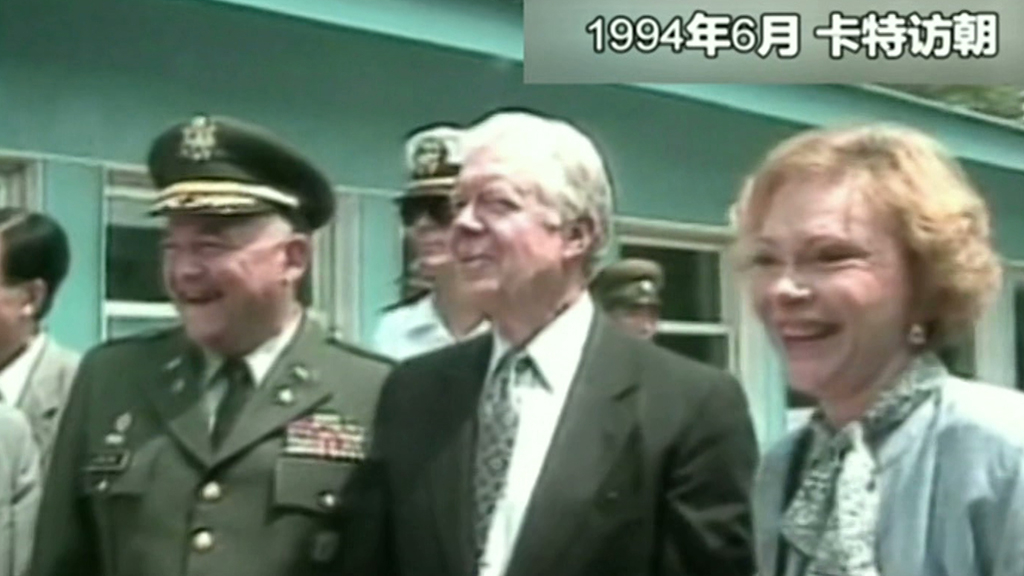
Politics
11:38, 09-Jun-2018
A look back at the diplomatic dance between Washington and Pyongyang
By Nathan King
04:25

The Korean Peninsula bears the distinction of being the first battlefield of the Cold War. Until the collapse of the former Soviet Union, US diplomacy with Pyongyang was non-existent. That changed in the 1990s – as concern grew over Pyongyang's plan to withdraw from the nuclear non-proliferation treaty.
The 25-year diplomatic dance between Washington and Pyongyang is as follows:
The 1990s: Jimmy Carter and Kim Il Sung

The end of the Cold War also meant the withdrawal of tactical nuclear weapons by the US and the then Soviet Union from global hot spots, including the Korean Peninsula. US troops remained at the Democratic People's Republic of Korea's (DPRK's) border.
In 1994, former US president Jimmy Carter went to Pyongyang in a bid to persuade DPRK leader Kim Il Sung to halt construction on nuclear reactors.
Later that year, Washington and Pyongyang signed the "Agreed Framework" freezing work on the reactors and production of plutonium, in return for fuel shipments and economic aid. This diplomacy, though difficult, bore fruit.
2000: Bill Clinton and Jo Myong Rok / Madeline Albright and Kim Jong Il

In 2000, DPRK senior military leader Jo Myong Rok met with former US president Bill Clinton. Then US secretary of state Madeline Albright traveled to Pyongyang to meet leader Kim Jong Il. She went in a bid to expand the Agreed Framework and pave the way for a presidential visit to Pyongyang. The attempt failed.
2002: George W. Bush and the 'Axis of Evil'

In 2002 George W. Bush, a new president, in response to the 9/11 terror attacks, declared an "Axis of Evil" lumping Pyongyang in with Washington's enemies in the Middle East. John Bolton, now national security adviser, was then in charge of arms control at the State Department. He accused the DPRK of cheating.
Pyongyang accused Washington of reneging on its commitments, and the Agreed Framework fell apart. In 2003, blaming US aggression, Pyongyang pulled out of the nuclear nonproliferation treaty. It was a signal that the nation was contemplating building an atomic bomb.
2003-2009: The six-party talks and the beginning of DPRK nuclear tests

After Pyongyang withdrew from the nonproliferation treaty, regional powers led by China held a series of so-called six-party talks. Despite intense diplomacy, Washington and Pyongyang remained at odds. In 2006, the DPRK conducted its first nuclear test, and sanctions followed. Even though the six-party talks lasted until 2009, a breakthrough remained elusive.
2009-2016: Barack Obama and Kim Jong Un

Under former president Barack Obama, the US embarked on a period of what it called "strategic patience," trying to bring Pyongyang to the negotiating table with economic sanctions. A new DPRK leader, Kim Jong Un, banned international weapons inspections as he moved forward with a nuclear weapons program at an accelerated pace.
2017 to present: Donald Trump and Kim Jong Un

The election of US President Donald Trump coincided with an escalation of nuclear and ballistic missile testing by Pyongyang, as well as an escalation in hostile rhetoric from both leaders.
"Rocket Man is on a suicide mission for himself and for his regime. The US is ready, willing and able, but hopefully this will not be necessary," President Trump said at a UN General Assembly meeting.
Both leaders threatened nuclear war. Kim Jong Un responded in a rare personal rebuke, calling the US President a "dotard."
However, a turnaround came just as fast. Capitalizing on a peace offering made by Kim Jong Un in his New Year's address, Republic of Korea (ROK) President Moon Jae-in invited the DPRK to compete in the Winter Olympics. The two Koreas walked out as one team. Diplomatic meetings were held, and two months later, there was a proposed summit.
A lot's gone on in the interim: two visits to Pyongyang by US Secretary of State Mike Pompeo, lots of behind-the-scenes diplomacy and one cancellation letter from the US president led to the highest level meeting between the two nations in nearly 20 years. It's all set the stage for a historic summit.
What's next?
While the Singapore Summit is historic, it's also going against history. In the past, Pyongyang and Washington have taken their time before high-level talks, with intense behind-the-scenes negotiations, and haggling over details. Distrust has dominated much of the diplomacy. This, however, is a diplomatic gamble. Both leaders appear to assume that something concrete might result before any deal is on the table. The potential risks and rewards are high.

SITEMAP
Copyright © 2018 CGTN. Beijing ICP prepared NO.16065310-3
Copyright © 2018 CGTN. Beijing ICP prepared NO.16065310-3